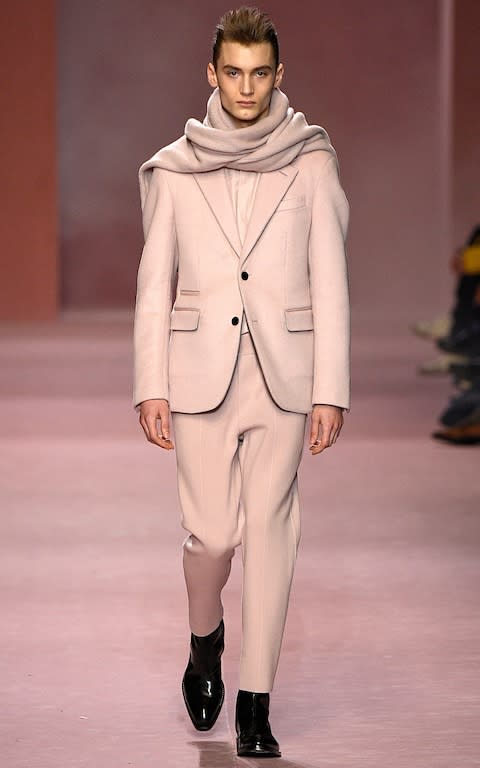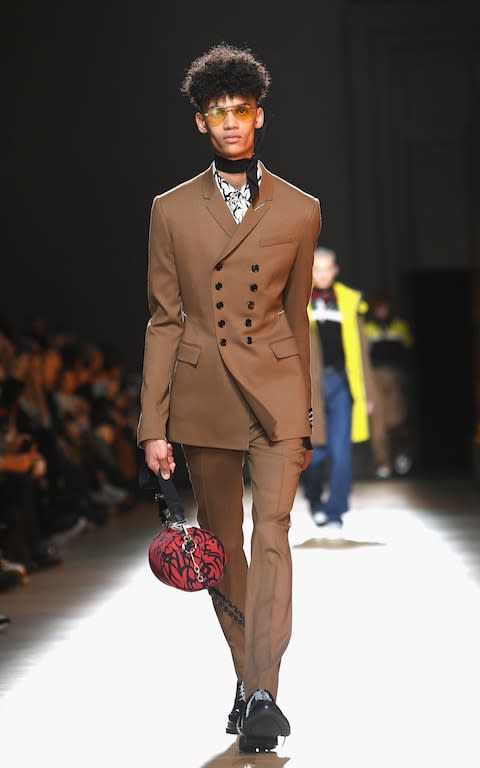The new dress code: the new rules for a gentler take on masculine style

The world of menswear is currently in flux. Anything too aggressively sexual feels inappropriate in the post-Weinstein age of Time's Up, Baroque frivolity has been tainted by the interiors of Trump Tower, and Mario Testino and Bruce Weber's once-iconic images of buff boys and glamazon girls exuding sex and power now appear outmoded following the allegations against the photographers of sexual misconduct. All the while, a gender-identity revolution has been bubbling away for several years, throwing out the rules of everything - from pronouns to fitting rooms.
Right now, menswear defined by loud statements, bling-worthy status symbols and well-cut traditionalism can feel somewhat démodé. It's sensuality - not sexuality - that has emerged as one of the most powerful images from the menswear shows, offering a softer side of modern man. Yet it isn't over-politicised or shouted about through slogans or graphics; that would be the sartorial equivalent of mansplaining.

Instead, there were gentler notions of luxury on display: at Hermès and Berluti, fine-gauge knits in saturated jewel tones, track blousons in treated silk, and elasticated-waist trousers, for instance. There were touches borrowed from the women's catwalks: high-waisted knife-pleat trousers at Prada, Kenzo and Lemaire; lilac chenille and pink knit sweaters at Raf Simons, Marni and Mackintosh; elegantly draped side panels on Lanvin's spliced knitwear and capes, and Chalayan's brown wool coats. Even among the city-slicker pinstripe classics at Giorgio Armani there was a slouchy crushed-velvet navy two-piece with shawl collar and tucked-in hem.
At Dior Homme, Kris Van Assche remixed Christian Dior's wasp-waisted Bar silhouette with traditional men's suiting. Back in 1947, the New Look for women was all exaggerated curves and a dozen metres of pleats as a glamorous riposte to Occupation-era austerity (some have said such gilded corsetry set the women's rights movement back a decade).

Today, however, the hourglass shape has been subverted by Van Assche. Here were streamlined suits in a plethora of fabrics, with nipped-in waists emphasised with a ribbon of white stitching and paired with slouchy trousers. In lieu of a tie, a black silk neckerchief, a nod to the femme within every fella.
Grace Wales Bonner, the mistress of the white suit, also presented beautifully feminised tailoring. The London-based designer's work has always felt imbued with spirituality. This time around she sent out abbreviated sailor jackets with powder-blue-and-white Vichy hoods, and Giacometti satin suits with flared trousers and ruched sleeves. Among the high points were luscious prints based on African-American artist Jacob Lawrence's paintings. Colourful, crowded, they represented for Wales Bonner 'a soulful expression of collective identity'.

Haider Ackermann's third collection for Berluti was no exception. The venue was entirely covered in a soft pink carpet. Out came fluffy white shearling coats and round-shouldered jackets over blushed rose suiting, oversized violet Japanese cashmere sweaters half-tucked in, sky-blue butter-soft leather trousers and an emerald suede trench. 'In a world that is louder than ever, I like the idea of a quiet man,' he explained. 'Serene, cool, collected, yet standing on his own two feet.'
Elsewhere, designers - at Gucci, Balenciaga, Saint Laurent, Givenchy, Burberry and Acne Studios, to name a few - have decided to merge their men's and women's collections, opting for streamlined gender-neutral narratives. It reflects a moment in which masculinity is redefining itself - in the midst of crisis.
Osman Ahmed is senior editorial associate at The Business of Fashion.
